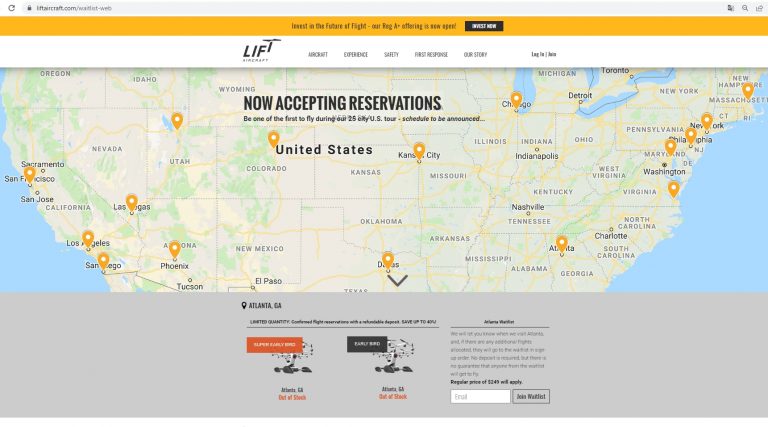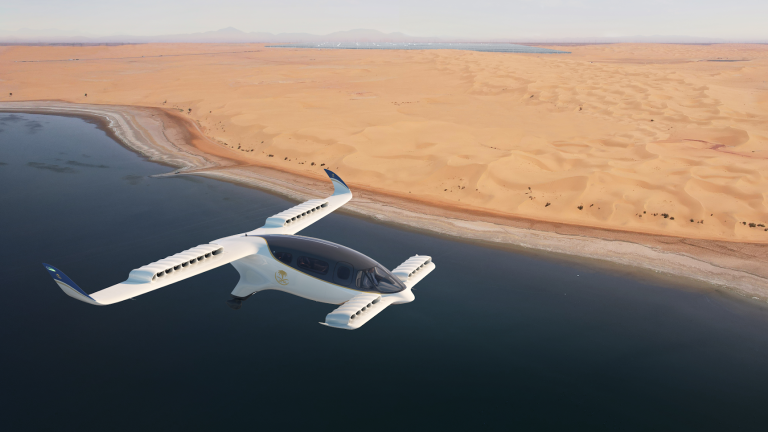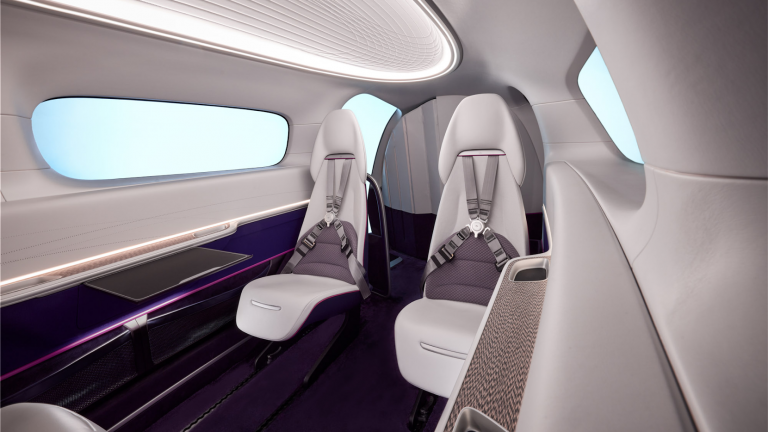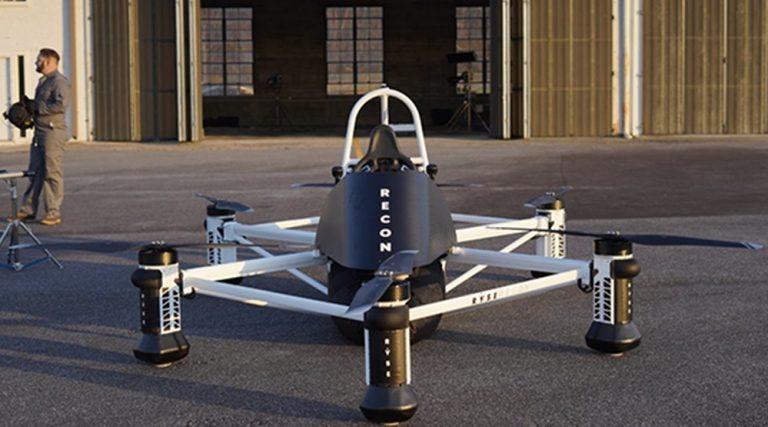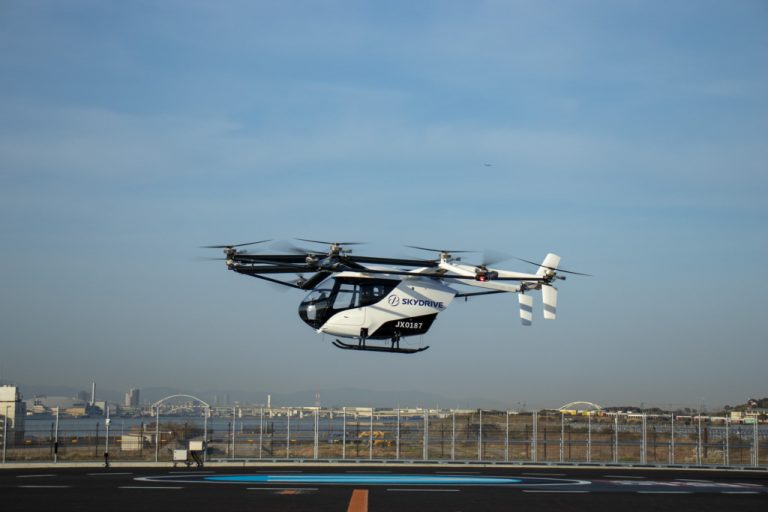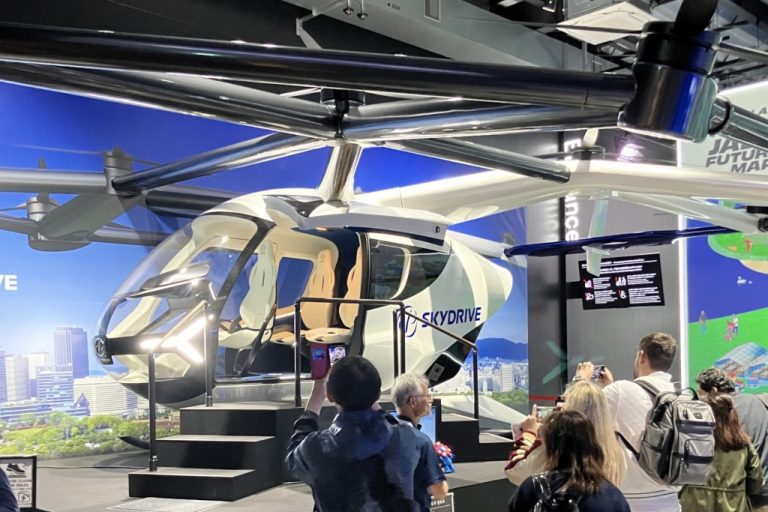Index A-Z - Air
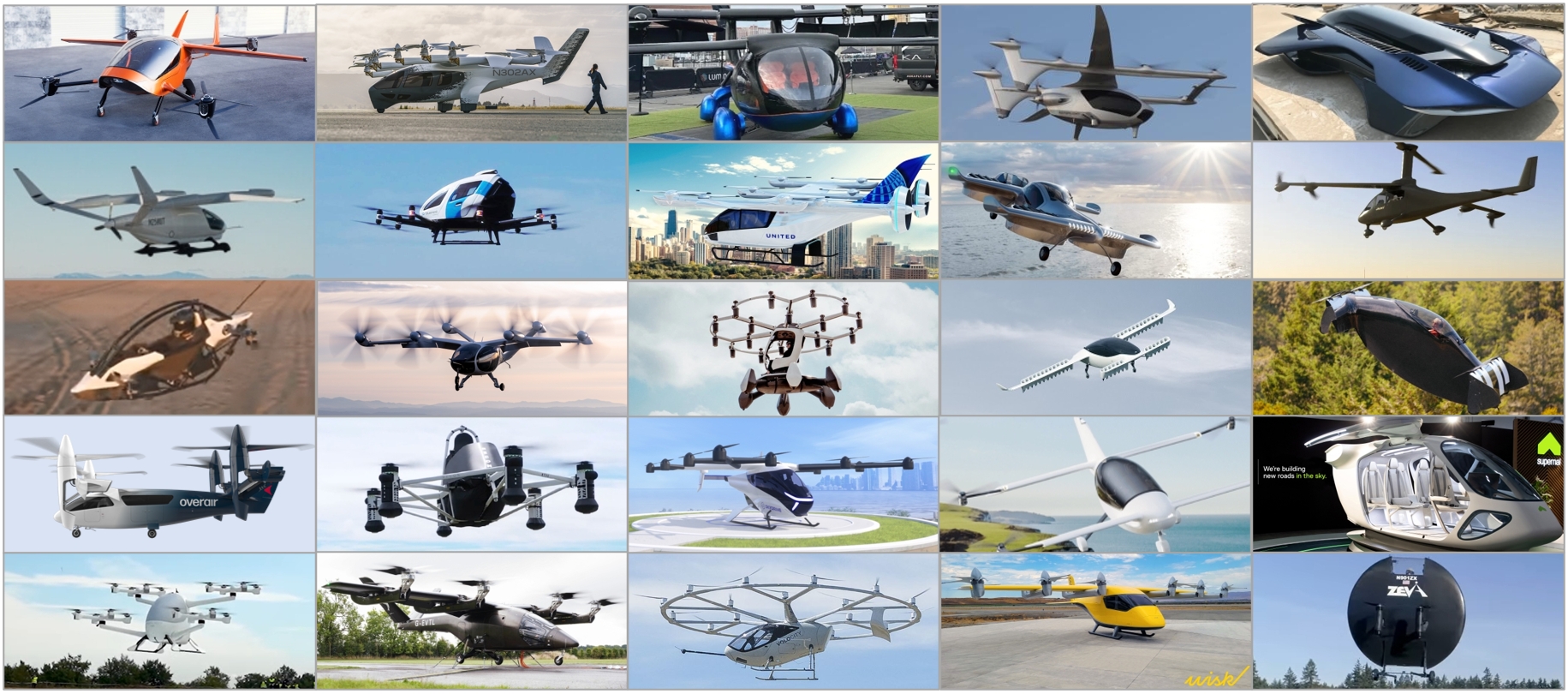
Air Airbus Alef Aeronatics Alpine Vertical Archer Aviation Aska Fly Autoflight Bellwether Industries Beta Technologies Crisalion Mobility Doroni Aerospace Ehang Electra ERC System Eve Air Mobility FAST Horizon Aircraft Jaunt Jetson Aero Joby Aviation Kitty Hawk LIFT Aircraft Lilium Opener Overair Pantuo Aviation Pivotal Ryse Aero Technologies SkyDrive Skyfly Technologies Supernal Aero Umiles Vaeridion Vertical Aerospace Volocopter Wisk Aero Xpeng Aerhot ZEVA Aero
Israeli start-up for wing-based eVTOL, founded in 2017. AIR is developing a 2-seat aircraft called AIR ONE with a wing and a twin tail unit (1st figure).
Addressed primarily to private customers, sales start is planned for 2024. Target markets are the USA, Europe, Australia and Israel. The entry price for the base model is currently $150,000, and 150 customers are already said to have made a down payment.
This company ideo video shows the AIR One in flight.

AIR ONE Full-Scale Prototype
(Mit freundlicher Genehmigung/Courtesy of AIR VEV Ltd. [Press Kit])

AIR ONE – Inclined vertical propellers
(Mit freundlicher Genehmigung/Courtesy of AIR VEV Ltd. [Press Kit])
Sources
[1] https://www.airev.aero/ (Homepage, Access 05.09.2022)
[2] https://www.faa.gov/documentLibrary/media/Advisory_Circular/AC_103-7.pdf (Access 05.09.2022)
[cs 05.09.2022, 18.09.2023]
[Update 01.02.2025]
At the end of January 2025, Bruno Even – CEO of Airbus’ helicopter division – announced that Airbus would pause development of the NextGen CityAirbus at the end of 2025 due to concerns about the maturity of the battery technology.
The prototype CityAirbus NextGen took off from the ground for the first time at the beginning of November 2024 and is to continue flying until the end of 2025 so that the company can “continue to learn from the technology and architecture”, according to Even. The launch of a new program depends on many factors, the maturity of the business model and the maturity of the technology “… some of them have to evolve to be able to launch a new program,” he told journalists.
Technical details were not provided, but it can be assumed that, from Airbus Helicopters’ point of view, the capacity of current Li-Io cells is not yet sufficient to represent a commercially viable use case for the NextGen CityAirbus.
In light of the progress currently being made in eVTOL development in the USA, Brazil and, above all, China, this interruption is all the more regrettable from a German perspective.
[Article from 31.07.2024]
The European aircraft manufacturer Airbus is developing its own wing-based-eVTOL under the project name NextGen CityAirbus. Airbus has opted for the propeller configuration PC2, i.e. the eight propellers are all mounted in a dedicated fixed position [1].
Airbus explicitly cites the simpler mechanical concept as an argument for this design decision; the NextGen CityAirbus is thus similar to the eVTOL from Beta Technologies and Autoflight.
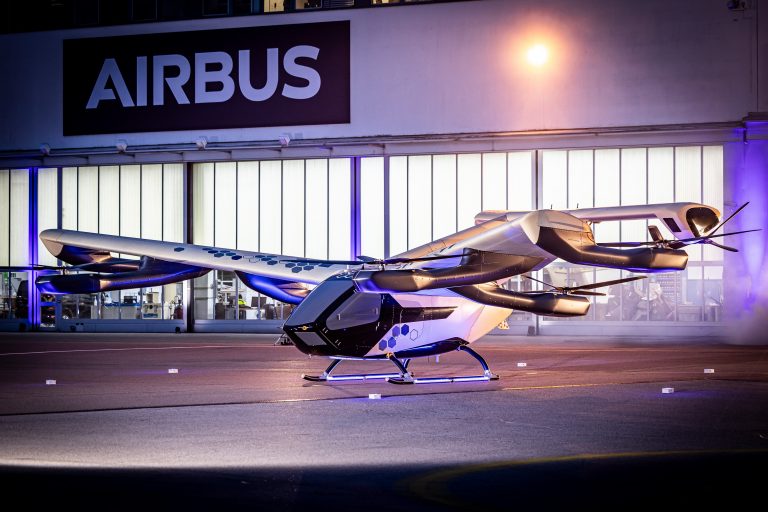
NextGen City Airbus – Side view
(Mit freundlicher Genehmigung/Courtesy of Airbus SAS [Press Relesae])
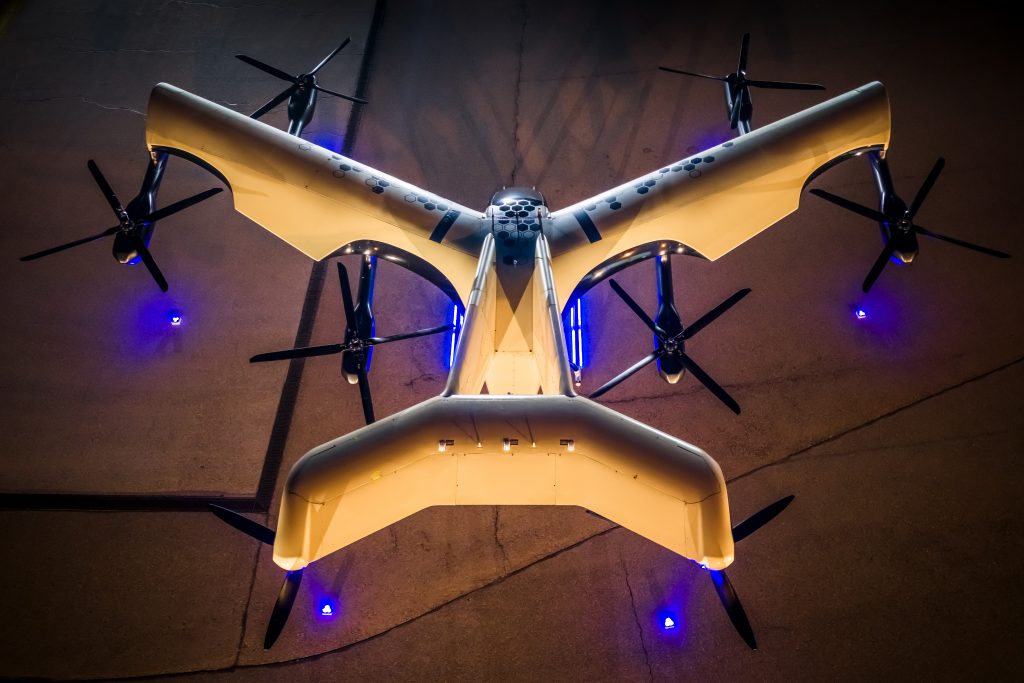
NextGen City Airbus – Top view
(Mit freundlicher Genehmigung/Courtesy of Airbus SAS [Press Relesae])
Sources
[1] https://www.airbus.com/en/newsroom/stories/2023-11-cityairbus-nextgen-leaves-no-milestone-unturned/ (Homepage, Access 31.07.2024)
[2] https://verticalmag.com/q-and-a/balkiz-sarihan-on-building-an-airbus-branded-evtol-aircraft/ (Access 31.07.2024)
[cs 31.07.2024]
Alef Aeronautics [↑] [↓] [⇑] [⇓]
US start-up for multicopters, which was founded in California in 2015; investors include well-known venture capital funds. The early entry of Tim Draper, who invested $3 million in the company, caused a sensation. Interestingly, Draper was also one of the first investors in Tesla and SpaceX [1].
The company is primarily targeting private customers, and sales are scheduled to start in Q4/2025. The entry price for the base model is currently $300,000.
Alef is developing a 2-seat flying car called MODEL A, which can drive on roads as well as fly in the air. Among multicopter startups, this gives Alef a unique selling point, as it is the only manufacturer developing a flying car with the technology of a multicopter.
The company Aska Fly is also working on a flying car, but relies on technology of wing-based eVTOL.

Model A from Alef Aeronautics
(Mit freundlicher Genehmigung/Courtesy of Alef Aeronautics Inc. [Press Kit])

Model A during forward flight (Animation)
(Mit freundlicher Genehmigung/Courtesy of Alef Aeronautics Inc. [Press Kit])
The Model A has 8 vertical propellers located in the front and rear of the vehicle, which are fully enclosed. The body has a grid-like structure so as not to block the vertical airflow (1st figure).
The advised range in the air is 177 km (110 ml) and on the road 322 km (200 ml).
From an animation video it can be seen that no horizontal propellers are planned for the Model A for the forward flight. Instead, the multicopter is turned to the sideand then tilted forward by about 75 degrees (2nd figure).
Maneuvered into this position, the vertical propellers can now provide propulsion. In order to provide the pilot with a forward view, the pass pod is rotatably mounted. Whether the Model A will be built and fly in the manner described remains to be seen, as only a prototype in the size of a model airplane exists so far.
The cell supplier is not known to the editors, but has probably not yet been determined..
Sources
[1] https://alef.aero/ (Homepage, Access 06.07.2023)
[cs 06.07.2023]
Alpine Vertical [↑] [↓] [⇑] [⇓]
US start-up for wing-based eVTOL, originally founded by Stephen Tibbits under the name ZEVA Aero.
ZEVA Aero has developed a single-seat prototype multicopters, all information can be found here.
Alpine Vertical is developing a two-seater wing-based VTOL with hybrid propulsion. The vertical ascent will be electric, while propulsion will be provided by a combustion engine.
Sources
[1] https:/https://alpine-vertical.com/ (Homepage, Access 07.09.2024)
[cs 07.09.2024]
Archer Aviation [↑] [↓] [⇑] [⇓]
US start-up for wing-based eVTOL founded in 2018 by Adam Goldstein and Brett Adcock in California; target market is commercial aviation.
The first prototype flight model is called Maker and has 6 tilt and 6 vertical propellers (propeller configuration PC3); first flight was Dec. 16, 2021.
The 1st test flight for the transistion maneuver (transition climb to forward flight) took place in November 2022, here you can see the not quite optimal edited video about it.
The Midnight(TM) production model was developed on the basis of the Maker, essentially adopting the technical concept from the Maker. The capacity of Midnight(TM) is 5 people (4 passengers plus 1 pilot), the typical flight profile is 32-80-km trips (20-50 miles), the top speed is 240 km/h (150 mph) [1].
Midnight uses a safety concept based essentially on redundant components such as e-machine, propulsion, power supply, etc., with no single point of failure. For central flight control, 4 independent computers with independent sensors and power supply are used.

Archer Aviation model Midnight
(Mit freundlicher Genehmigung/Courtesy Archer Aviation Inc. [Media Kit])

Archer Aviation model Midnight – Interieur
(Mit freundlicher Genehmigung/Courtesy Archer Aviation Inc. [Media Kit])
Certification of the Midnight is scheduled to take place by 2024, with production by the car manufacturer Stellantis (contract manufacturing) [2].
United Airlines has signed a letter of intent to procure 200 Midnight aircraft.
The HV battery will be supplied by Molicel, a Taiwanese subsidiary of Taiwan Cement Corporation (TCC) [3]. Molicel specializes in the development and production of high-performance cylindrical lithium-ion cells, which are used by the Wiliams Formula 1 team and other eVTOL start-ups (e.g. Vertical Aerospace).
Archer Arviation is publicly traded (NYSE, WKN A3C3BQ, ISIN US03945R1023).
Sources
[1] https://archer.com/ (Homepage, Access 13.01.2022)
[2] https://www.archer.com/News/stellantis-to-build-electric-aircraft-with-archer-and-provide-strategic-funding-for-growth (Access 13.01.2023)
[3] https://www.archer.com/News/archer-selects-molicel-to-supply-battery-cells-for-its-production-midnight-aircraft (Access 13.01.2023)
[cs 13.01.2023, 18.09.2023]
US start-up for wing-based eVTOL founded in 2018 by Guy and Maki Kaplinsky in Los Altos/California. Aska is developing a flying car called the ASKATM A5that can both drive on the road and fly in the air; its target market is primarily private customers.
Among the start-ups for wing-baed eVTOL, Aska has a unique selling point as it is the only manufacturer developing a wing-based flying car (1st picture).
The company Alef Aeronautics is also working on a flying car, but relies on multicopter technology.
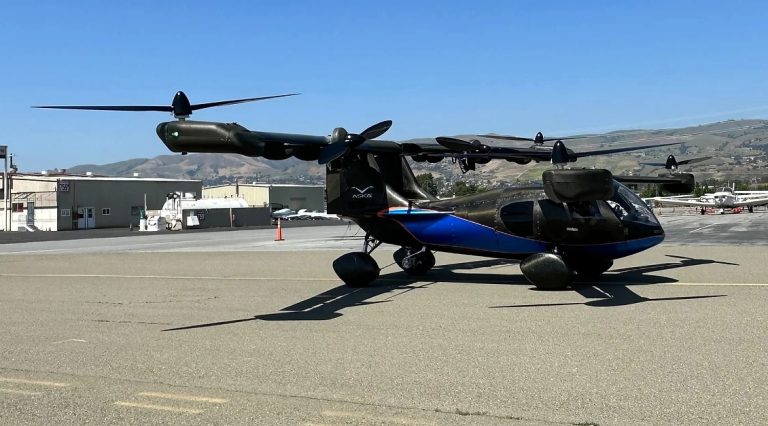
Flying car ASKA(TM) A5 on air field
(Mit freundlicher Genehmigung/Courtesy of ASKA/NTF Inc. Ltd. [Homepage])

Flying car ASKA(TM) A5 in public traffic
(Mit freundlicher Genehmigung/Courtesy of ASKA/NTF Inc. Ltd. [Homepage])
With folded wings it has the footprint of an American SUV, for road travel it is powered by 4 wheel hub motors (2nd picture).
For flight the two wings can be unfolded, these are equipped with 2 tilt and 4 vertical propellers (propeller configuration PC3).
Capacity is 4 people (3 passengers plus 1 pilot), range is 400 km (250 miles) with range extender at a top speed of 240 km/h (150 mph). Certification is expected by 2025, with series production starting in 2026 [1].
The cell supplier is not known to the editors.
Sources
[1] https://www.askafly.com/ (Homepage, Access 11.01.2023)
[cs 11.01.2023, 19.09.2023]
Chinese start-up for wing-based eVTOL, founded in 2016 by Tian Yu in Shanghai. Autoflight started with development and production of cargo drones and has now entered the development of passenger air vehicles; target market is commercial air transport.
First model is an eVTOL with 8 vertical propellers for takeoff and 1 thrust propeller for forward propulsion with a capacity of 3 passengers plus a pilot (propeller configuration PC2).
The range is specified as 240 km (150 ml), the top speed as 210 km/h (130 mph), and the maximum payload is specified as 410 kg (900 lbs) [1].
In February 2023, Autoflight demonstrated a range of 250 km in a test flight, see the video here. According to Autoflight, this is the farthest flight of an eVTOL ever.

Prosperity I GEN 4 – Exterieur
(Mit freundlicher Genehmigung/Courtesy of Autoflight Limited [Homepage])

Prosperity I GEN 4 – Interieur
(Mit freundlicher Genehmigung/Courtesy of Autoflight Limited [Homepage])
Autoflight is aiming for worldwide distribution, and a German subsidiary has been established at Augsburg Airport for European flight certification, which is planned for 2025. Test flights with the near-production flight model “Prosperity I” are scheduled to start in 2023.
Autoflight’s cell supplier is not known to the editorial team.
Sources
[1] https://www.autoflight.com/ (Homepage, Access 27.09.2022)
[2] https://www.autoflight.com/en/news/autoflight-announces-latest-prosperity-i-proof-of-concept-full-test-fl (Access 27.09.2022)
[3] https://www.manager-magazin.de/unternehmen/tech/autoflight-chinesische-firma-will-ab-2023-flugtaxi-in-augsburg-testen-a-dfb3b66b-45f4-4de2-8ee3-1fba7c3f0c69 (Access 27.09.2022)
[cs 27.09.2022, 19.09.2023]
Bellwether Industries [↑] [↓] [⇑] [⇓]
British multicopter start-up founded in London in 2019, with parts of the company team already working on eVTOL projects since 2014. Target market is primarily private customers [1].
Here’s a video of a flying protoy type.
Bellwether is currently developing a flying device called Oryx, which seems to come from a Bat–Man movie. Oryx represents the 3rd generation and its dimensions are slightly larger than an SUV (6.2m long and 3.8m wide). The unique selling point of Bellwether is the complete encapsulation of the propellers. These are located inside the aircraft, avoiding injuries from rotating propellers [2].
Oryx is expected to cover the distance between Heathrow Airport and Canary Wharf, London’s new business district, in 8 minutes at a speed of 140km/h.
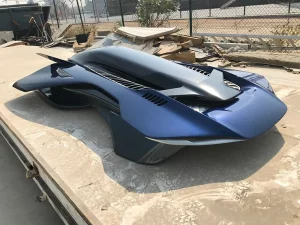
Bellwether Multicotper Volar
(Mit freundlicher Genehmigung/Courtesy of Bellwether Industries Limited [Homepage])
We did not find any data on further details such as certification and series production on the homepage.
The cell supplier of Bellwether is not known to the editors.
Sources
[1] https://www.bellwether-industries.com/ (Homepage, Access 19.12.2022)
[2] https://verticalmag.com/press-releases/bellwether-reveals-new-generation-flying-car-model/ (Access 19.12.2022)
[cs 19.12.2022]
Beta Technologies [↑] [↓] [⇑] [⇓]
US start-up for wing-based eVTOL founded in 2017 in Burlington, Vermont by Kyle Clark, an experienced pilot, engineer and entrepreneur; target market is commercial aviation.
Watch this company video to learn more about the Beta Technologies story and see the eVTOL aircraft fly.
The current prototype ALIA-250 has 4 fixed vertical propellers for takeoff and landing and one thrust propeller for propulsion (propeller configuration CK2).
The capacity is 6 people (1 pilot, 5 passengers), the range is about 190 km, and the maximum takeoff weight is reported to be about 3180 kg (6999 lbs) [1].

Alia at test flight over lake camplain, Vermont, USA
(Mit freundlicher Genehmigung/Courtesy of Beta Technologies Inc.. [Media Kit])

AC fast charging station from Beta Technologies
(Mit freundlicher Genehmigung/Courtesy of Beta Technologies Inc.. [Media Kit])
We have not found any information on the homepage about the important future milestones such as “certification” and “SOP” (Start of Production) of ALIA-250.
The cell supplier is Cuberg, which has been bought by Northvolt in the meantime. Cuberg has specialized in the development of high energy lithium metal cells, where the anode is made of lithium. The energy density is 380Wh/kg, and the dentrite formation typical of metal anodes is said to be prevented by a special liquid electrolyte [2].
Beta Technologies has also developed the ground infrastructure including charging technology for its flying machines, using used containers.
Beta has developed its own charging station based on AC technology, unlike to the automotive industry using DC.
Sources
[1] https://beta.team/ (Homepage, Access 29.09.2022)
[2] https://www.cuberg.net/ (Access 29.09.2022)
[cs 29.09.2022, 19.09.2023]
Crisalion Mobilities [↑] [↓] [⇑] [⇓]
Crisalion develops a 1-seater multicopters with roll stabilization. Crisalion is a Spanish group of companies founded in 2016 by 2 brothers under tthe name UMILES. Previously they worked on unmanned video drones for the film and advertising industry. In particular, they also developed technologies for the roll stabilization of drones.
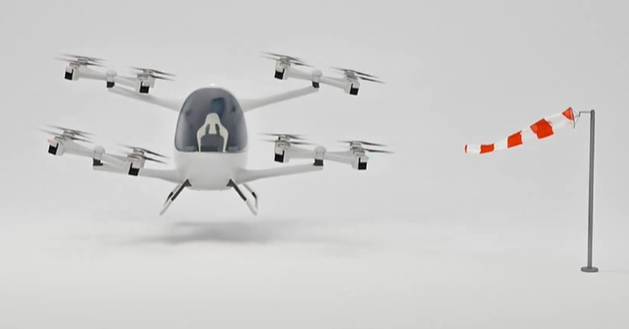
UMILES roll stabilization technology
(Mit freundlicher Genehmigung/Courtesy of UMILES Technologies S.L. [Homepage])
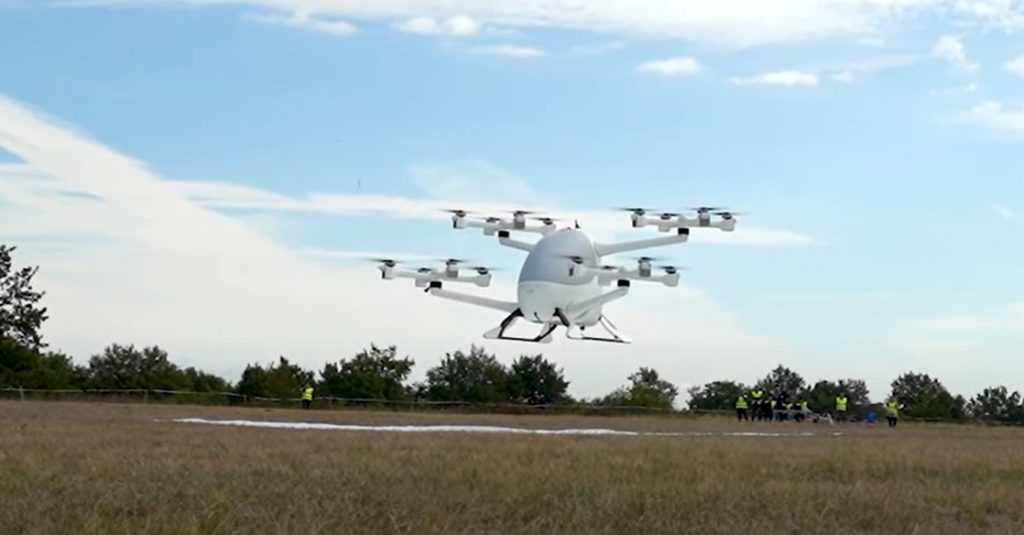
Unmanned test flight 2022 in Toulouse, Frankreich
(Mit freundlicher Genehmigung/Courtesy of UMILES Technologies S.L. [Homepage])
The illustration above left shows the principle. In each case, 4 propellers are combined in a movable carrier frame; in the event of a crosswind, the carrier frame is tilted against the wind direction. The cabin itself remains stable, which is a significant comfort gain for potential passengers.
The principle of roll stabilization is now to be applied to a manned 1-seater multicopter. This has 16 vertical propellers, a payload of 100 kg, a top speed of 80 km/h and a range of 15 km. Unmanned test flights have already been conducted in 2022. the figure above right shows an unmanned test flight in Toulouse.
A winged vertical takeoff is also planned, but unlike the multicopter, no airworthy prototype exists here yet.
A roadmap with the dates for certification and series production of the multicopter is not known.
Sources
[1] https://crisalion.com/ (Homepage, Access 28.04.2024)
[cs 20.01.2023, 28.04.2024]
Doroni Aerospace [↑] [↓] [⇑] [⇓]
US start–up for multicopters, founded in 2016 in Miami/Florida by Doron Merdinger, target market are mainly private customers.
Doroni is developing a 2-seat multicopter called H1 for private customers, the model has 8 vertical and 2 horizontal propellers, with the vertical propellers encapsulated in 2 stub wings. The size of the H1 is adapted to a standard US double garage.
The range is expected to be about 100 km (60 ml), with a top speed of 225 km/h (60 ml). The plan is to certify the aircraft as a light sport aircraft, allowing US citizens with a valid driver’s license to fly the H1 after only a 20h course [1].
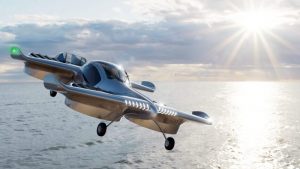
Doroni H1
(Mit freundlicher Genehmigung/Courtesy of Doroni Aerospace Inc. [Press Relase])
The sales price is to be $250,000, with sales starting in the 2nd half of 2025.
The cell supplier is not known to the editors, but may not yet be determined.
Sources
[1] https://www.doroni.io/ (Homepage, Access 21.06.2023)
[cs 21.06.2023]
Chinese multicopters start–up founded in Guangzhou in 2014. Ehang is working on both personal transport (Figure 1) and cargo drones; the target market is commercial aviation [1].
On the Ehang homepage, a variety of flight videos can be found, as an example here is the video of a medical transport in Belgium.
For both cargo and passenger transport, Ehang relies on the concept of autonomously flying eVTOLs in combination with flight control centers (Figure 2).
The Ehang 216 flight model has a payload of 220kg, a range of 30 km (at maximum payload) and a top speed of 130 km/h. It has a total of 16 propellers, with 2 propellers arranged in opposite directions.

Ehang test flight in Spain, 11.10.2022
(Mit freundlicher Genehmigung/Courtesy of Guangzhou EHang Intelligent Technology Co. Ltd. [Homepage])

Ehang flight control center (animation)
(Mit freundlicher Genehmigung/Courtesy of Guangzhou EHang Intelligent Technology Co. Ltd. [Homepage])
Ehang can already point to a large number of test and demonstration flights. The first test flight in Europe took place on October 11, 2022, in Lugo, Galicia, at the Spanish Institute of Aeronautical Technology. The flight was conducted as part of the EU funded project “Air Mobility Urban – Large Experimental Demonstration (“AMU-LED”).
Ehang’s cell supplier is unfortunately not known to the editors.
Ehang is listed on the stock exchange (Nasdaq, ISIN US26853E1029, WKN A2PWWB).
Sources
[1] https://www.ehang.com/ (Homepage, Access 19.10.2022)
[cs 19.10.2022, 19.09.2023]
US start-up for aircraft with hybrid propulsion and ultra-hort take-off capability (eSTOL), which was only founded in 2020 by John Langford. The concept was developed in collaboration with MIT professors John Hansman and Mark Drela and is a deliberate alternative to the many eVTOL start-ups [1].
Dispensing with the vertical take-off capability reduces energy consumption during take-off and landing and should therefore enable longer ranges. You can see the video of the launch of a first prototype here.
Electra is developing a 9-seater passenger aircraft with a target range of 500 km. A surface with a length of only 92m (300ft) is required for take-off and landing.
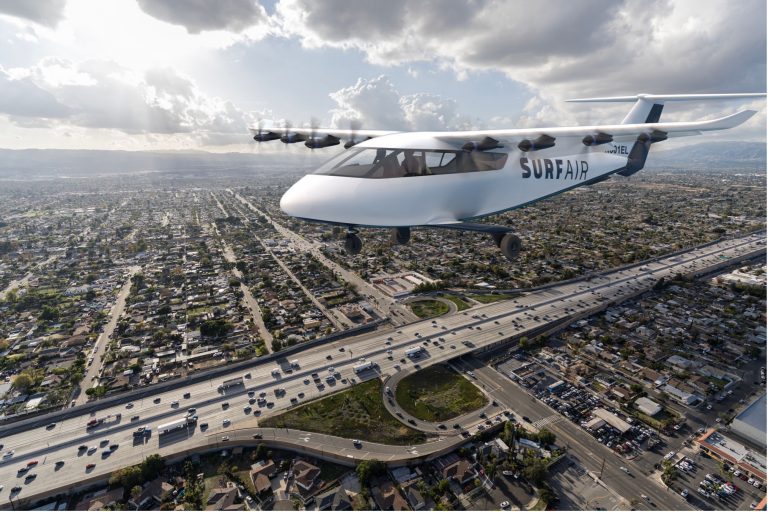
Skizze Electra-Flugzeug
(Mit freundlicher Genehmigung/Courtesy of Electra.Aero [Press Release])
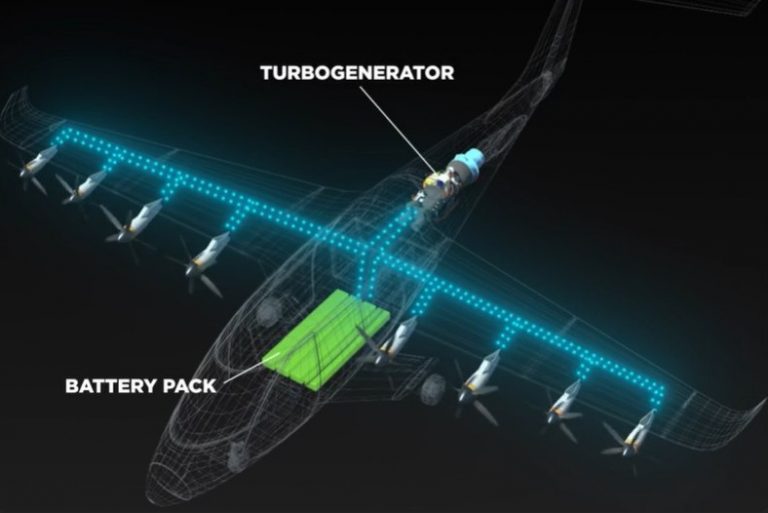
Animation hybrider Powertrain von Electra
(Mit freundlicher Genehmigung/Courtesy of Guangzhou Electra.Aero [Homepage])
Electra is developing a hybrid propulsion system consisting of a turbine, a power generator, a battery and 8 electrically driven propellers (see figure).
The turbine has no mechanical link to the propellers, but only generates electricity for the battery and the propellers. It is therefore a range extender concept that also has become popular in the car sector with Li-Auto.
During take-off and landing, the propellers are powered by the battery and generator, allowing the generator to be smaller. The aim is to achieve fuel savings of 40% compared to conventional drives.
Certification and first deliveries are planned for 2028 and 2029.
Sources
[1] https://www.electra.aero/ (Homepage, Access 17.10.2024)
[cs 17.10.2024]
German start-up for wing-based eVTOL, which was founded a few years ago by David Löbl and others, initially in stealth mode and presented to the public in 2024. ERC is developing an eVTOL specifically for air rescue and the recumbent transportation of patients, which currently gives it a unique selling point among eVTOL start-ups [1].
The first airworthy full-scale model for test flights with ground fixation has 8 non-tilting vertical propellers; horizontal propulsion propellers are still missing. In other words, ERC relies on the not-tilt propeller configuration PC2 similar to Airbus, Autoflight, Beta Technologies, and EVE,
The main advantage of this design is that the transition maneuver, i.e. the transition from vertical to horizontal flight during take-off and from vertical to horizontal flight during landing, can be flown at a 90° angle. These characteristics are particularly important for use in air rescue operations, which require precise landing.
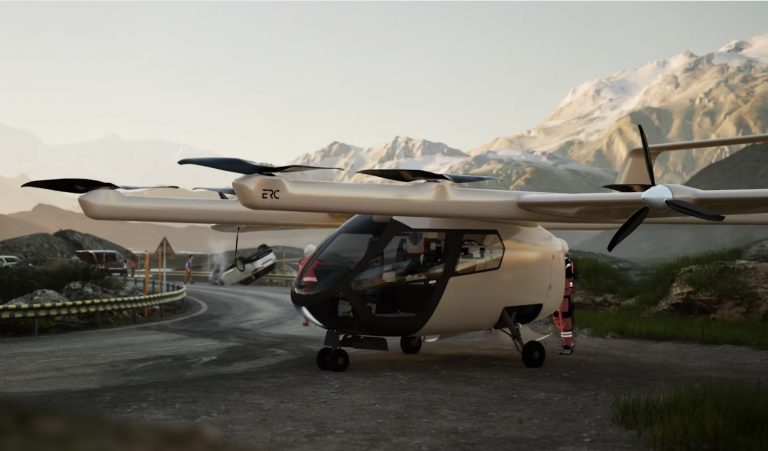
ERC eVTOL during rescue operations – Exterieur (Animation)
(Mit freundlicher Genehmigung/Courtesy of eRC System GmbH [Homepage])
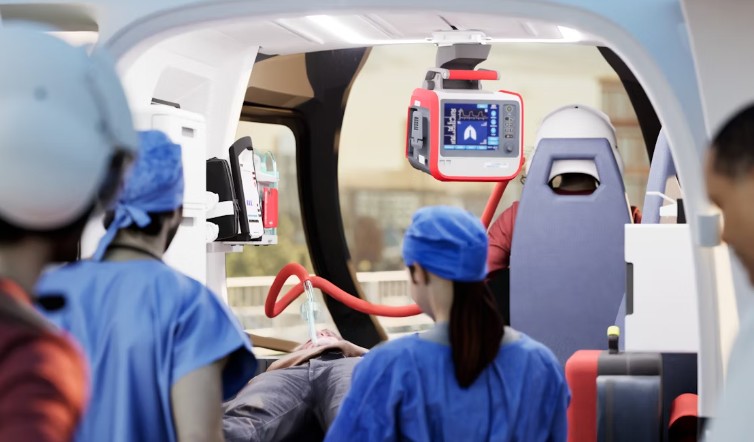
ERC eVTOL – Interieur
(Mit freundlicher Genehmigung/Courtesy of eRC System GmbH [Homepage])
The ERC-eVTOL will have a payload of 450 kg and a range of 180 km. The cabin is being developed in close cooperation with medical experts from the air rescue sector.
The first flight in the rescue service is planned for 2029; the aim is to achieve 33% of the operating costs of a conventional rescue helicopter.
Sources
[1] https://www.erc-system.com/ (Homepage, Access 04.10.2024)
[cs 04.10.2024]
EVE Air Mobility [↑] [↓] [⇑] [⇓]
Start–up for wing-based eVTOL founded in 2020 by Brazilian aircraft manufacturer Embraer, the fourth largest aircraft manufacturer after Airbus, Boeing and Bombardier. The target market is commercial air transport.
Eve is developing a eVTOL for passengers (4 passenger plus 1 pilot) with 8 vertical and 1 propulsion propeller (propeller configuration PC2) [1].
Eve is collaborating with well-known suppliers from the aeronautical industry, e.g. the avionics system is developed by Thales [2].

eVTOL from EVE Air Mobility – Exterieur (Animation)
(Mit freundlicher Genehmigung/Courtesy of Eve Holding, Inc. [Homepage])

eVTOL from EVE Air Mobility – Interieur (Animation)
(Mit freundlicher Genehmigung/Courtesy of Eve Holding, Inc. [Homepage])
United Airlines invested $15 million in Eve Air Mobility in September 2022 and ordered 200 eVTOLs, with an option to purchase another 200 [3].
In total, orders for 2850 eVTOL aircraft had been received by August 2023, so Eve sees itself as the market leader. The first deliveries are scheduled to take place in 2026 [4].
Unfortunately, the cell supplier is not known to the editors.
Eve Air Mobility is listed on the stock exchange (NYSE, ISIN US29970N1046, WKN A3DKW8).
Sources
[1] https://ir.eveairmobility.com/ (Homepage, Access 19.09.2023)
[2] https://verticalmag.com/news/eve-enlists-thales-develop-evtol-aircraft (Access 25.10.2022)
[3] https://eveairmobility.com/united-invests-another-15-million-in-electric-flying-taxi-market-with-eve (Zugriff 25.10.2022)
[4] https://eveairmobility.com/eve-and-dhl-partner-to-design-a-supply-chain-concept-for-evtol-support/ (Zugriff 25.10.2022)
[cs 25.10.2022, 19.09.2023]
German start-up from Berlin that develops flight simulators for eVTOL pilot training. The company was founded by the former Lufthansa pilot, flight instructor and entrepreneur Walter Drasl, who has sadly since passed away.
As almost all eVTOL start-ups only equip their vertical take-off aircraft with only one pilot’s seat (exception: Beta Technologies), classic pilot training with an accompanying flight instructor is not possible.
The training of eVTOL pilots will therefore primarily have to take place using flight simulators.
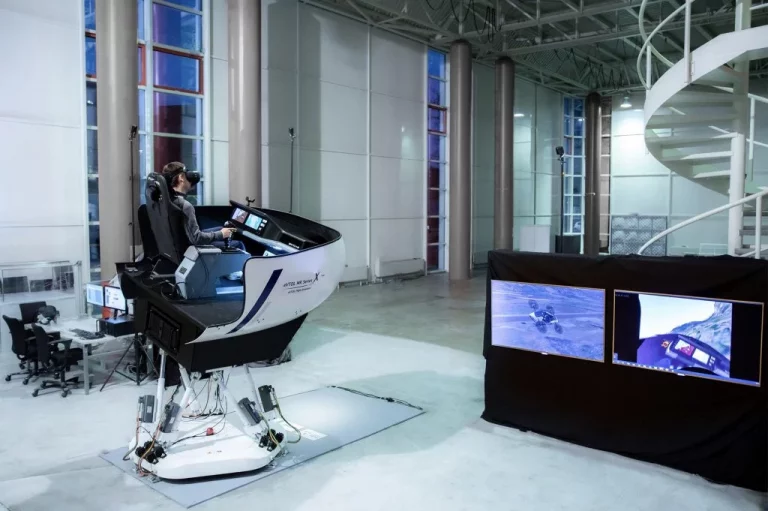
Mixed reality eVTOL flight simulator from FAST
(Mit freundlicher Genehmigung/Courtesy of Future Aviation Simulation Technologies GmbH [Homepage])
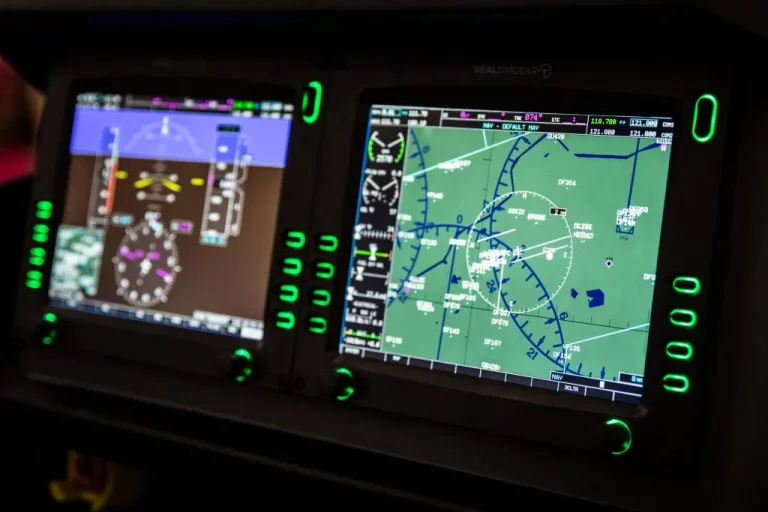
Virtual instrument display in the FAST eVTOL flight simulator
(Mit freundlicher Genehmigung/Courtesy of Future Aviation Simulation Technologies GmbH [Homepage])
FAST uses a mixed reality approach for its flight simulator (see illustrations):
- The motion platform, which is used to simulate the forces involved in flying, and the side stick for controlling the eVTOL are realized using hardware components.
- The eVTOL cockpit and the display systems are displayed virtually in VR goggles.
This concept makes it possible to realize flight simulators for a variety of eVTOL types (multicopter, wing-based eVTOL, etc.) with a uniform standard hardware, thus reducing complexity and costs.
Sources
[1] https://fast-group.aero/ (Homepage, Access 18.06.2025)
[cs 18.06.2025]
Horizon Aircraft [↑] [↓] [⇑] [⇓]
Canadian start-up for wing-based eVTOL founded in 2013 by Brian Robinson, a former Canadian Air Force pilot, and his son Brandon Robinson in Lindsay, Ontario [1].
Horizon Aircraft is developing a wing-based eVTOL for up to 7 people (6 passengers plus 1 pilot) with 14 vertical and 1 propulsive propeller (propeller configuration PK2) with the project title Cavorite X7 [2].
The special feature of the Horizon design is the vertical propellers integrated into the wings, a concept that the start-up has patented:
- During vertical flight, the covers on the wings are moved forwards and backwards so that the vertical propellers are free-standing and can generate vertical thrust.
- During forward flight, the vertical propellers do not rotate and are covered by movable covers to avoid turbulence on the wings.
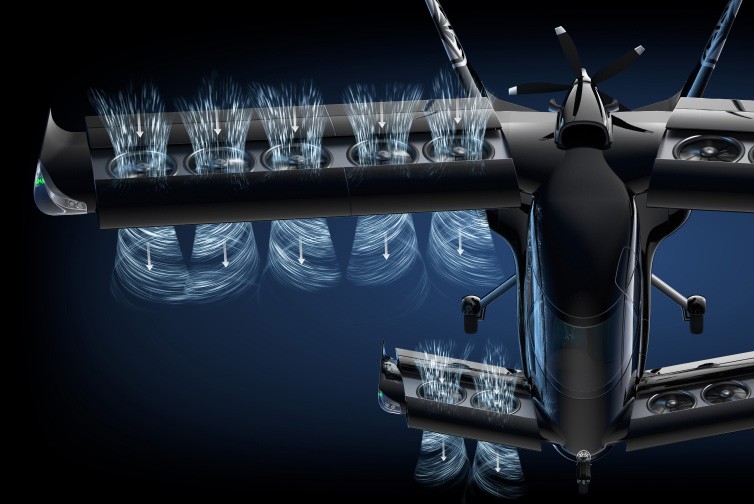
Sketch of Horizon eVTOL in vertical flight
(Mit freundlicher Genehmigung/Courtesy of New Horizon Aircraft Ltd. [Homepage])
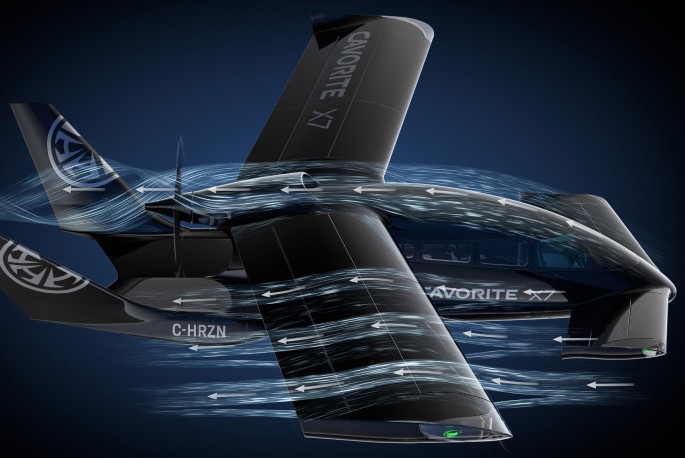
Sketch of Horizon eVTOL in horizontal flight
(Mit freundlicher Genehmigung/Courtesy of New Horizon Aircraft Ltd. [Homepage])
Similar to the Lilium Jet, the Cavorite X7 has a smaller wing at the front (canard) and a larger wing at the rear. There are 2 vertical propellers integrated in the front wings and 5 in the rear wings.
Note: Some illustrations also show 6 propellers in the rear wings; the technical concept does not yet appear to have been finalised.
In terms of key performance parameters such as range, top speed and capacity, Horizon plans to outperform or at least equal the competitors explicitly mentioned on the website Archer, Ehang, Joby and Lilium . However, the comparison is not entirely fair, as Horizon relies on a hybrid drive, while the competitors use a purely battery-electric power train.
The aim is to achieve a range of 800 kilometres, a top speed of 450 km/h and a capacity of 7 people (6 passengers + pilot). However, unlike the aforementioned competitors, Horizon does not yet have an airworthy full-scale model.
Sources
[1] https://evtolinsights.com/2021/01/qa-brandon-robinson-of-horizon-aircraft-talks-about-its-aircraft-technology-and-exciting-plans-for-the-future/ (Access 14.11.2024)
[2] https://www.horizonaircraft.com/ (Homepage, Access 14.11.2024)
[cs 14.11.2024]
Canadian start–up, which has been part of the US aerospace group AIRO Group since March 2022; target market is commercial air transport.
Jaunt is developing a wing-based eVTOL with one large vertical rotor for lift and 4 horizontal propellers for propulsiopn fixed to the wings (propeller configuration PC2).
The aircraft looks like a helicopter with a wing [1]. However, in contrast to a classical helicopter, the vertical rotor is required only for vertical takeoff and not for propulsive flight. During the propulsive flight, the vertical rotor rotates only at low speed because the lift forces are generated by the wing.

Flug-Animation von Jaunt
(Mit freundlicher Genehmigung/Courtesy of Jaunt Air Mobility LLC. [Homepage])

Jaunt-eVTOL in New York (Animation)
(Mit freundlicher Genehmigung/Courtesy of Jaunt Air Mobility LLC. [Homepage])
The range is said to be 130-190 km (80-120 miles), the capacity is said to be 5 persons (1 pilot, 4 passengers) and the top speed is said to be 280 km/h (175 mph).
First test flights are scheduled to start in 2023, with aviation certification and production in larger numbers planned for 2026.
Unfortunately, the cell supplier is not known to the editors.
Sources
[1] https://jauntairmobility.com/ (Homepage, Access 19.09.2023)
[cs 25.10.2022, 19.09.2023]
Swedish multicopters startup founded in 2017 by Tomasz Patan and Peter Ternström. Jetson is the only eVTOL startup we know of that already sells its product to private customers.
Watch the fascinating video of a Jetson ONE flying over a dune landscape here (1st image). This video brings back memories of Luke Skywalker gliding over the desert landscape of Tatooine in his X34 Landspeeder in the 1st Stars movie (2nd image).
The Jetson ONE is a single-seat multicopter designed with 8 vertical propellers, with 2 propellers mounted in opposite directions on each suspension.

Multicopter Jetson ONE from Jetson Aero
(Mit freundlicher Genehmigung/Courtesy of Jetson AB [Homepage])

Luke Sykwalker in X34 Landspeeder (Star Wars, 1977)
(Mit freundlicher Genehmigung/Courtesy of THE WALT DISNEY COMPANY)
The maximum flight time is 20 min, the maximum speed is 100 km/h, and the maximum weight of the pilot is 95 kg [1]. The Jetson ONE thus falls into the category of ultralight vehicles in the USA, for example, and may be flown for private purposes without a pilot’s license and does not have to be registered [2].
The Jetson ONE is produced and sold in small series, and the series produced in 2022 and 2023 are already sold out. The current price is $98000, with a down payment of §8,000.
Unfortunately, the cell supplier is not known to the editors.
Sources
[1] https://www.jetsonaero.com/ (Homepage, Access 06.12.2022)
[2] https://www.faa.gov/documentLibrary/media/Advisory_Circular/AC_103-7.pdf (Access 07.12.2022)
[cs 07.12.2022]
US start-up for wing-based eVTOL, which was founded in California back in 2009, making Joby one of the eVTOL pioneers. The target market is commercial air traffic.
The capacity of the Joby-eVTOL is 5 people (1 pilot, 4 passengers). As a typical example of an inner-city use case, Joby cites passenger transport from Manhattan Heliport in New York to JFK Airport. By car, the trip takes about 50 min (without congestion), whereas with the Joby-eVTOL it takes only 7 min [1].
In October 2022, Joby announced that the U.S. airline Delta had invested $60 million in Joby with the option to increase that investment up to $200 million if certain milestones are met.
In September 2023, Joby announced that production of the Joby-eVTOL would take place in Ohio at Dayton International Airport. Production is scheduled to start in 2024, with deliveries beginning in 2025. It should be possible to build up to 500 vertical takeoffs per year at this plant [2].
On this video you can see the transistion maneuver from the Joby-eVTOL. The transition from vertical ascent to forward flight is at an angle of about 30 degrees.

Wing-based eVTOL von Joby Aviation
(Mit freundlicher Genehmigung/Courtesy of Joby Aviation. (c) [Media Kit])
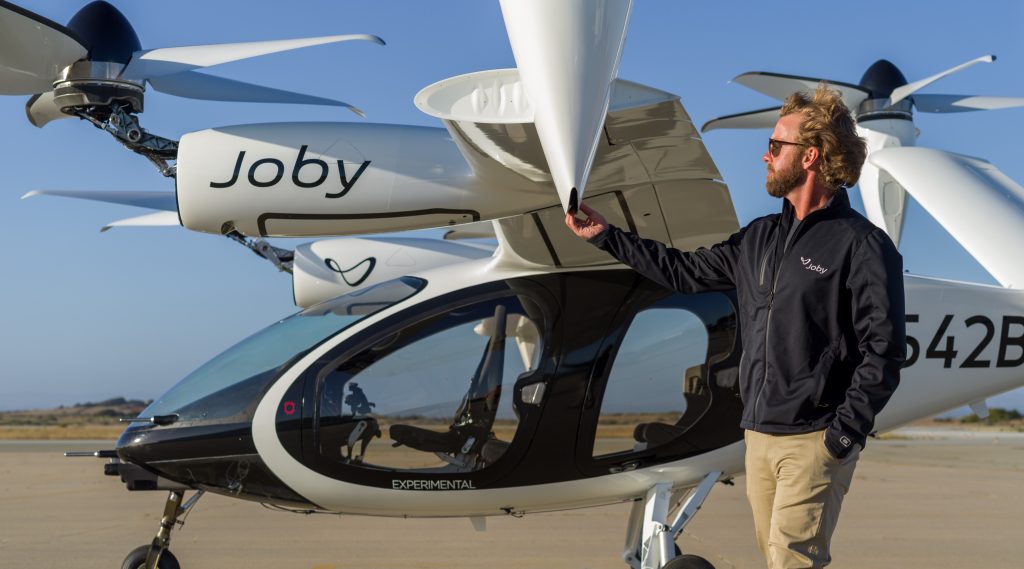
Interieur
(Mit freundlicher Genehmigung/Courtesy of Joby Aviation. (c) [Media Kit])
However, there are indications that cells from the automotive sector with NMC-811 chemistry are used, the cell format remains open according to this source [3].
Sources
[1] https://www.jobyaviation.com/ (Homepage, Access 09.12.2022, 20.09.2023)
[2] https://www.jobyaviation.com/news/joby-selects-dayton-ohio-first-scaled-manufacturing-facility (Access 20.09.2023)
[3] https://www.osinto.com/post/what-joby-aviation-learned-from-telsa-batteries-charging-cooling (Access 20.09.2023)
[cs 09.12.2022, 20.09.2023]
Attention: Business activity was discontinued in September 2022!
US start-up for wing-based VTOL, which was founded in California back in 2010 by Larry Page (co-founder of Google) and the German-born former Stanford professor Sebastian Thrun. The most recently developed flight model is a small, single-seat wing EVTOL with 8 tilt propellers (propeller configuration PC1).
Sebastian Thrun has worked intensively on autonomous vehicles in his scientific career (including at Google), so it is not surprising that Kitty Hawk’s aircraft should also fly autonomously. A corresponding video of a test flight could be seen on the homepage [1].
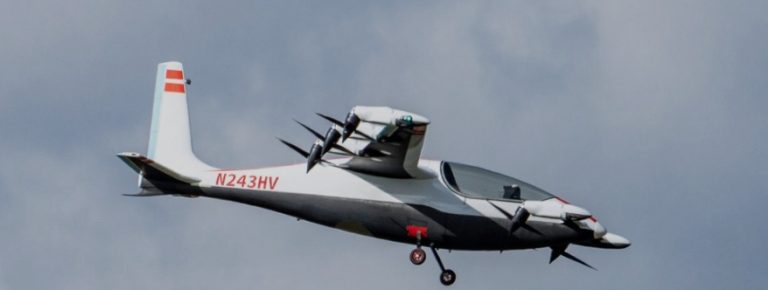
eVTOL from Kitty Hawk
(Mit freundlicher Genehmigung/Courtesy of Kitty Hawk Corporation [Homepage])
Kitty Hawk’s business model envisaged remote-controlled flight operations, which does not seem very profitable for a 1-seater flight model only. Selling the flight model to private customers was apparently not planned.
Sources
[1] https://www.kittyhawk.aero/ (Homepage, Access 09.12.2022)
[cs 09.12.2022]
US start-up for Multicopters, which was founded in 2017 by Matt Chasen in Austin, Texas, with the target market being primarily private customers.
LIFT has developed a single-seat multicopter called HEXA with 18 propellers (1st figure), which can be flown by laymen after a short instruction [1]. The flight model falls under the Ultralight Vehicle regulations in the USA, i.e. it may be flown without a pilot’s license and also does not require certification [2].
In cooperation with the US Army, LIFT is investigating whether HEXA technology can also be used in the military sector. Potential use cases include the transportation of medical products and the transportation of injured persons.
LIFT’s business model is based on a rental model, i.e. private customers without flying experience have been able to fly with HEXA themselves at the company’s headquarters in Austin since May 2024. All that is required beforehand is two hours of training using a virtual reality simulator.
Further locations in the USA are planned; the rental price for the 3-5 minute flight is $249.
The sale of HEXA to private customers is apparently not planned.
Outside the USA, the LIFT multicopter was presented during a demonstration flight at the Expo in Osaka, Japan, in May 2025.
Unfortunately, the cell supplier is not known to the editors.
Sources
[1] https://www.liftaircraft.com/ (Homepage, Access 10.12.2022)
[3] https://www.faa.gov/documentLibrary/media/Advisory_Circular/AC_103-7.pdf (Access 10.12.2022)
[2] https://www.liftaircraft.com/waitlist-web (Access, Zugriff 10.12.2022)
[cs 10.12.2022, 25.04.2025]
[Update 03.04.2025]
In February 2025, Lilium had to file for insolvency for the second time because, contrary to all expectations, no money had been transferred from the investor consortium Mobile Uplift Corporation GmbH to the business accounts of the Munich-based eVTOL start-up.
Lilium had previously filed for insolvency in October 2024 after a state guarantee for EUR 100 million (EUR 50 million from the federal government, EUR 50 million from the Free State of Bavaria) failed to materialize.
In connection with the refusal of the 50 million guarantee by the federal government, reference should also be made to the sometimes very critical reports on Lilium in aerospace journals.
Aerokurier, for example, fundamentally doubts the technical feasibility of the Lilium jet [9]. Specifically, it concerns the performance data promised by Lilium, which, according to the authors, cannot be achieved with today’s lithium-ion technology. The battery does not have enough capacity to provide enough energy for vertical take-off plus forward flight with a commercially viable range when fully loaded (6 passengers plus pilot).
[Article from 20.09.2023]
German start-up for wing-based VTOL, founded in 2015 by Daniel Wiegand, Sebastian Born, Patrick Nathen and Matthias Meiner in Munich; target market is commercial aviation.
Klaus Roewe has been Lilium’s CEO since August 2022; Roewe was previously a manager at Airbus for many years, where he was responsible for the development of the A320 Neo, among other things [1].
The transistion maneuver (transition from vertical takeoff to forward flight), which is particularly critical for wing-based eVTOL, has already been successfully tested in test flights, as you can see in this video.
The original business model envisaged a kind of ride-sharing service at cab prices. In the meantime, there are plans to offer short-haul flights for business customers or solvent private customers at higher prices, or to sell the aircraft to airlines as well [2].
Lilium has already signed cooperation and preliminary purchase agreements with a number of companies, such as in the UK [3], Switzerland [4] and China [5].
The supplier structure is also under development, including Aciturri for the fuselage [6], Saint–Gobain for the windows [7] and Customcells for the lithium-ion cells [8].
Lilium has developed a wing-based eVTOL with ducted fans, which are basically electric turbines (eTurbine). With this approach, Lilium has a unique selling point among eVTOL start-ups. The ducted fanss avoid air turbulence at the propeller tips and reduce the noise.
The flight model is equipped with 30 eTurbines and two wings. The front, smaller wing is located in the cockpit area (duck wing), while the rear, larger wing is mounted at the tail. The eTurbines are groups attached to the rear, upper area of the wings. There are 12 eTurbines on the front, smaller wing, and 18 on the rear wing (1st figure).
Similar to the slat-flap system of a conventional aircraft, the eTurbines can be flipped from a vertical to a horizontal position (propeller configuration PC1) to generate thrust for both vertical takeoff and forward flight.
The cabin capacity is designed for a maximum of 6 passengers plus a pilot, but a particularly comfortable variant with 4 passengers is also to be produced (Figure 4).
The range is 175 km, and the top speed is 250 km/h.
Lilium’s cell supplier is the German company Customcells, which specializes in the development and production of small- and medium-sized series of lithium-ion cells [8].
Lilium is listed on the stock exchange (NYSE, ISIN NL0015000F41, WKN A3CYXP).
Sources
[1] https://lilium.com/ (Homepage, Access 11.12.2022)
[2] https://www.sueddeutsche.de/wirtschaft/lilium-flugtests-1.5666226 (Access 11.12.2022)
[3] https://lilium.com/newsroom-detail/lilium-partners-with-evolare (Access 20.09.2023)
[4] https://lilium.com/newsroom-detail/lilium-signs-agreement-with-Air-Dynamic (Access 20.09.2023)
[5] https://lilium.com/newsroom-detail/lilium-signs-agreement-with-heli-eastern (Access 20.09.2023)
[6] https://lilium.com/newsroom-detail/significant-milestone-with-the-commencement-of-fuselage-assembly (Access 20.09.2023)
[7] https://lilium.com/newsroom-detail/lilium-and-saint-gobain-aerospace-team-up-on-windows (Access 20.09.2023)
[8] https://lilium.com/newsroom-detail/lilium-partners-customcells (Access 20.09.2023)
[9] https://www.aerokurier.de/elektroflug/lilium-jet-dossier/ (Zugriff 29.10.2024)
[cs 11.12.2022, 20.09.2023, 29.10.2024, 25.12.2024]
US start-up for wing-based VTOL founded in 2018 in Santa Ana in California u. A. Abe Karem of; target market is commercial aviation.
Abe Karem has a career in aviation spanning more than 50 years and has been involved in a wide range of aviation projects. Investors include South Korean group Hanwa, which has invested $145 million in Overair.
Overair is developing a wing-based eVTOL called Butterfly with only 4 tilt propellers, with 2 propellers mounted on the front wing and 2 on the tail (propeller configuration PC1). At 20 feet (6 m) in diameter, the propellers are unusually large, which Overair says increases efficiency over models with many smaller propellers. The propeller system is not a new development, rather Overair uses the results of various technology programs of the Department of Defence or NASA [1].

Sketch eVTOL from Overair
(Mit freundlicher Genehmigung/Courtesy of Overair Inc. [Homepage])
Sources
[1] https://www.overair.com/ (Homepage, Access 11.12.2022)
[1] https://www.overair.com/overair-receives-145-million-investment-from-hanwha-group.html (Access11.12.2022)
[cs 12.12.2022]
Pantuo Aviation [↑] [↓] [⇑] [⇓]
Attention: It can be assumed that the business has been discontinued, as the last entries on the homepage are from 2021.
Chinese start-up for wing-based VTOL from Shanghai. Pantuo is developing a wing-based eVTOL that has many similarities to Lilium´s flight model. In a press release dated Nov. 30, 2021, Pantuo Aviation is even explicitly described as the Chinese answer to Lilium. However, unlike Lilium, Pantuo is still in the design phase, i.e., a full-scale, flight-capable model does not yet exist [1].
The Pantuo flight model has a front, smaller wing in front of the cockpit (duck wing) and a rear, larger wing at the tail. A total of 22 electric turbines are mounted on both wings, which have a larger diameter compared to Lilium. The wings can be folded from vertical to horizontal, also here Pantuo differs from Lilium, because with Lilium only the electric turbines can be adjusted (propeller configuration PC1).

Sketch flight model from Pantuo
(Mit freundlicher Genehmigung/Courtesy of Pantuo Aviation [Homepage])
The capacity of the cabin is designed for 4 passengers plus pilot, the range is said to be 250 km and the top speed 300 km/h.
Unfortunately, the cell supplier is not known to the editorial team.
Sources
[1] https://www.pantuo.mobi/en/ (Homepage, Access 12.12.2022)
[cs 12.12.2022]
US start-up for wing-based eVTOL, which was founded in Palo Alto, California, in 2008 under the name SkyKar and subsequently renamed Opener.
It is primarily aimed at private customers; the price starts at $190,000. Interested customers can already make a down payment, with delivery scheduled to begin in June 2024.
Pivotal has developed a single-seat wing-based eVTOL called Helix with 2 wings and 8 propellers. The front, slightly shorter wing is in front of the cockpit (duck wing), the rear wing is mounted at the tail. On each wing 4 vertical propellers are mounted, which are inclined forward (propeller configuration PC4).
The first manned test flight was performed in October 2021, demonstration flights in front of larger audiences with the predecessor model BlackFly took already place at the Pacific Air Show 2022. See the video here.

Demonstration flight with BlackFly (Predecessor model of Helix)
(Mit freundlicher Genehmigung/Courtesy of Pivotal, LCC [Homepage])
Helix’s range is 20 miles (32 km) plus 20% reserve, and its top speed is 60 mph (100 km/h), electronically limited to meet ultra-light vehicle specifications in the US. This allows Helix to be flown in the U.S. without a pilot’s license or registration [2].
Unfortunately, the cell supplier is not known to the editors.
Sources
[1] https://pivotal.aero/ (Homepage, Access 01.03.2024)
[3] https://www.faa.gov/documentLibrary/media/Advisory_Circular/AC_103-7.pdf (Access 12.12.2022)
[cs 12.12.2022, 01.03.2024]
Ryse Aero Technologies [↑] [↓] [⇑] [⇓]
US start-up for multicopters from Ohio, which was founded by Mick Kowitz, target market are farmers (private customers) in the USA [1].
Ryse has developed a single-seat multicopter with 6 propellers that falls under the Ultralight Vehicle Regulation (UVR) in the USA and can therefore be flown without a pilot’s license or registration. According to the UVR, the maximum speed is limited to 100 km/h (60 mph), the payload is 113 kg (250 lb), and the maximum flight time is 25 minutes.
On this video you can see the mulicopter flying.
Interestingly, Ryse sees its main customers among U.S. farmers who manage farms with very large acreage. With the aircraft, Ryse wants to make it easier for farmers to do aerial work, such as crop growth checks, rounding up and searching for missing cattle, inspecting fences, etc. [2].
The accumulators sit directly on the motor pods and can be changed on the ground. The cell supplier for the accumulators is not known to the editors.t.
Sources
[1] https://ryseaerotech.com/ (Homepage, Zugriff 14.12.2022)
[2] https://www.farmprogress.com/technology/ryse-aero-technologies-lets-farmers-take-sky-0
[cs 14.12.2022]
Japanese multicopters start-up established in 2018 in Koromo-Cho or Toyota City in Aichi Prefecture. Since 2019 there is a partnership agreement with Toyota. Its target market is commercial aviation.
Other investors include a number of Japanese banks and companies, such as Suzuki Motor Corporation [1].
Skydrive is developing a multicopter called SD-05, which is very similar to the Volocity from Volocopter in terms of design and application profile.
The SD-05 has a capacity of 3 people (1 pilot plus 2 passengers) and has 12 propellers, it is said to have a top speed of 100 km/h and a range of 5-10 km with a flight time of 5-10 min. The maximum take-off weight is 1100 kg.
The first public demonstration flight was carried out in April 2025 at the EXPO in Osaka/Japan (see illustration).
Suppliers include Thales for the FCR (Flight Control System) and EP Systems for the battery system [2].
Unfortunately, the cell supplier is not known to the editorial team.
[1] https://en.skydrive2020.com/ (Homepage, Access 14.12.2022)
[2] https://en.skydrive2020.com/archives/7345 (Access 15.12.2022)
[cs 15.12.2022, 25.04.2025]
Skyfly Technologies [↑] [↓] [⇑] [⇓]
Skyfly Technologies is a subsidiary of the British ADS Group, which is active in the aerospace, defense and security business areas [1].
Skyfly is developing a small 2-seat wing-based VTOL called Axe with 2 equal-sized wings and 4 forward-inclined vertical propellers (propeller configuration PC4). The front wing is in front of the cockpit (duck wing), the rear wing is mounted at the tail, 2 vertical propellers are mounted per wing. Flight control is solely by propeller speed control, i.e. there are no rudders, elevators or ailerons.
Skyfly addresses mainly private aviations. The Axe flight model can already be ordered on the Skyfly homepage for a deposit fee of 1000 pounds. The base price is currently 150,000 pounds net, additionally special equipment like a range extender generator (50,000 pounds) or an additional battery pack (25,000 pounds) can be ordered.
Axe is said to have a top speed of 100 mph (160 km/h) and a range of 100-200 miles (160-320 km), with a payload of 172 kg.
With these performance specs, Axe no longer falls under the Ultralight Vehicle Regulation in the U.S., meaning the aircraft can only be flown with a pilot’s license.
Deliveries will start in 2024, and currently 22 Axe aircraft are already reserved [3].
The cell supplier of SkyDrive is not known to the editors.
Sources
[1] https://www.adsgroup.org.uk/ (Access 15.12.2022)
[2] https://skyflytech.com/ (Access 15.12.2022)
[3] https://skyflytech.com/order/ (Homepage, Access 15.12.2022)
[cs 15.12.2022]
Supernal Aero is a subsidiary of Korean automaker Hyundai, founded in November 2021 in Irvine, California [1].
Supernal is developing a wing-based eVTOL, of which only few technical details are known so far; the target market is commercial aviation.
On the homepage, a so-called “concept vehicle” is shown as a graphic with a wing and a V-tail. At the wing there is one longitudinal beam per side, at the front there is 1 tilt propeller and at the rear there are 2 vertical propellers. On the rear V-tail there is 1 more folding tilt on each side.
So in total this model sees 4 folding tilt and 4 vertical propellers (propeller configuration PC3), with this configuration the design resembles the Midnight model from Archer Aviation.
Whether this “concept vehicle” already represents the final design remains to be seen.

Cabine model of Supernal presented at Farnborough Airshow 2022
(Mit freundlicher Genehmigung/Courtesy of Supernal [Media Kit])
At the Farnborough Airshow 2022 in the UK, Supernal has exhibited a cabin model of the “Concept Vehilce”, apparently the passenger capacity will be 4 passangers plus 1 pilot.
Flight operations are scheduled to begin in 2028, and along the way Supernal will advance certification in the U.S. and Asia.
It was also announced at the show that EP Systems has been selected as the supplier for the battery system [2].
Sources
[1] https://supernal.aero/ (Homepage, Access 16.12.2022)
[2] https://newsroom.supernal.aero/ep-systems-42c1254e1a97 (Access 16.12.2022)
[cs 16.12.2022]
UMILES has been renamed to Crisalion Mobility.
German start-up for electric short-haul aircraft (eCTOL), founded in 2021 by Ivor van Dartel and Sebastian Seemann in Munich. Vaeridion is developing a 9-seater regional plane for commercial air traffic, with this capacity the aircraft will be certified according to CS-23 level 3 [1][2].
The cockpit is designed for 2 pilots and enables visual (VFR) and instrument flight (IFR). As things stand, the cabin is not being developed as a pressurized cabin, which limits the flight altitude to approx. 3000 m.
The main aim is to improve transport connections between regions that have neither a large airport nor a fast rail link.
In Germany, for example, there are 24 commercial airports with 55 scheduled flights. If you include the smaller, regional airports, there are 209 airports with up to 2789 connections [3].
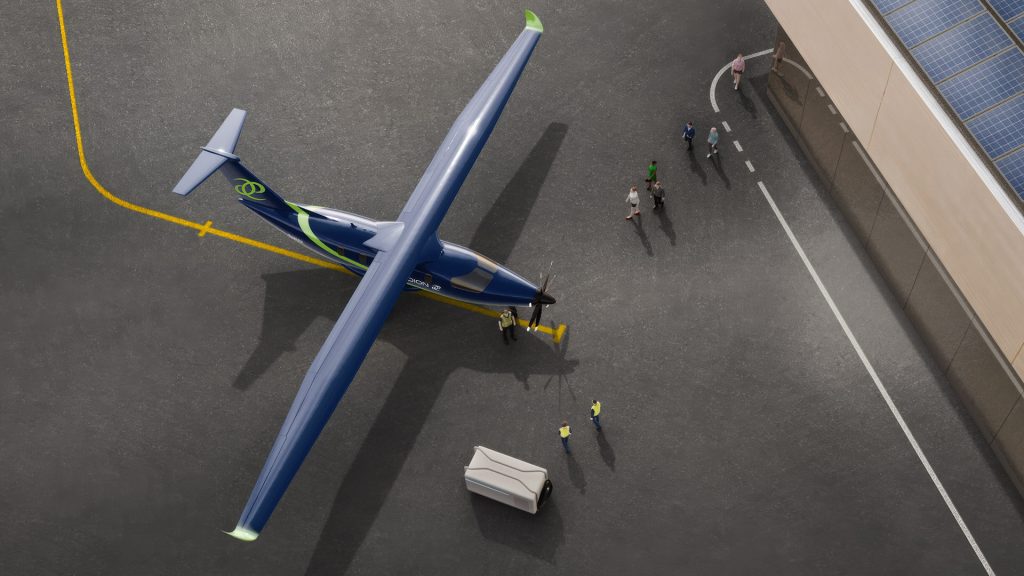
Electric airplane from Vaeridon (Animation)
(Mit freundlicher Genehmigung/Courtesy of Vaeridon GmbH [Homepage])
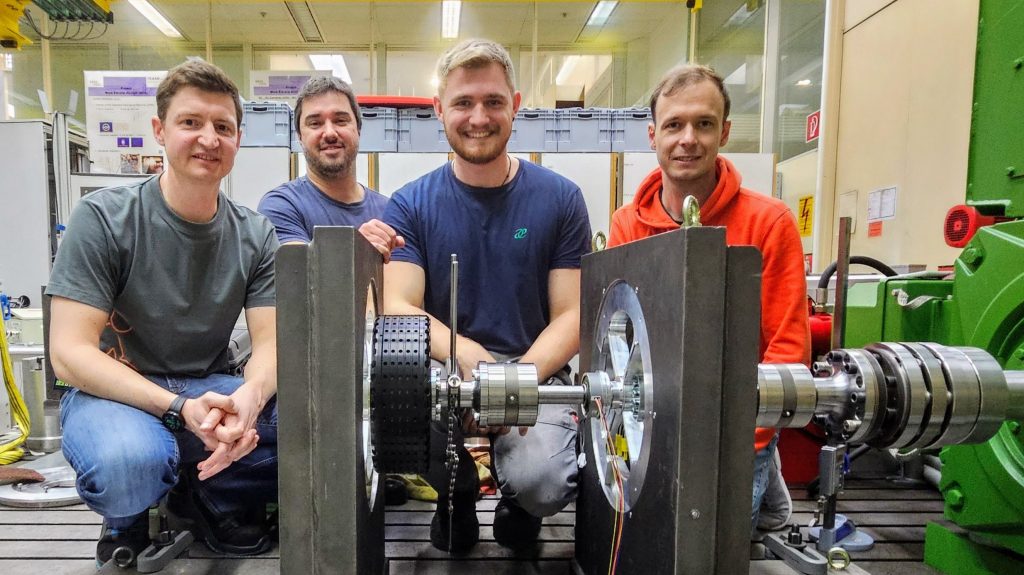
Function test “Disconnect electric motor after failure”
(Mit freundlicher Genehmigung/Courtesy of Vaeridon GmbH [Press Release])
The aircraft has one propeller at the front and 2 redundant electric drive motors. If one motor fails, the defective motor is disconnected from the drive train via a clutch; the technological concept has already been validated in the laboratory at the Technical University of Munich (see picture).
The battery modules are housed in the wing and are easy to replace, as they are expected to age more quickly during flight. The Li-Io cells are supplied by Customcells [4].
The aim is to achieve a range of up to 500 km, with the first test flights scheduled for 2027. Regular flight operations and series production are scheduled to start in 2029.
Sources
[1] https://vaeridion.com/ (Homepage, Access 07.10.2024)
[2] https://www.easa.europa.eu/sites/default/files/dfu/CS-23%20Amendment%205.pdf (Access 07.10.2024)
[3] https://www.bavairia.net/2024/06/19/https-www-bavairia-net-events-save-the-date-aam-forum-2024/ (Access 07.10.2024)
[4] https://customcells.com/another-step-towards-electrified-aviation-customcells-enters-cooperation-with-vaeridion/ (Access 07.10.2024)
[cs 07.10.2024]
Vertical Aerospace [↑] [↓] [⇑] [⇓]
British start-up for wing-based VTOL founded by Stephen Fitzpatrick in Bristol in 2016; target market is commercial air transport.
Stephen Fitzpatrick describes himself as a serial entrepreneur who has founded several companies and owned a Formula 1 team. Vertical Aerospace’s investors and development partners include companies such as American Airlines, Honeywell (flight control system), Microsoft, Rolls-Royce (engine manufacturer), and Virgin Atlantic [1].
As of January 2023, Vertical Aerospace had approximately 1400 pre-orders for the aircraft, with volume production of the VX4 scheduled to begin in 2025.
Vertical Aerospace also works with a safety concept based on redundant components (e-motor, e-motor control, HV battery, etc.), among other things, which means that the failure of a component such as a propeller during flight can be tolerated and can in no way lead to the crash of the aircraft (no single point of failure).
During an unmanned test flight on 09.08.2023, during which the flight capability was to be tested in the event of an engine failure, an accident occurred which damaged the prototype [2].
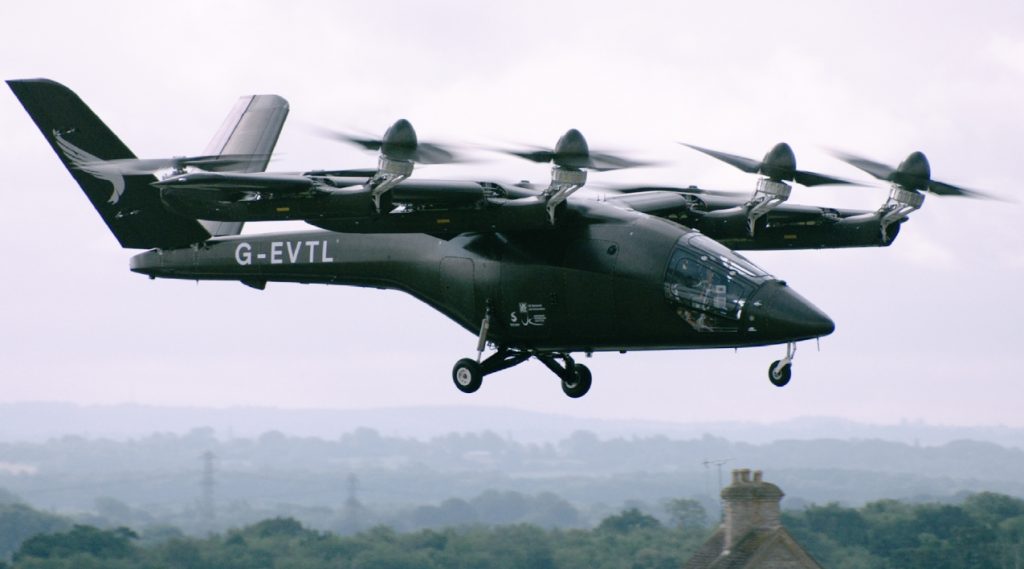
VX4 from Vertical Aerospace at test flight
(Mit freundlicher Genehmigung/Courtesy of Vertical Aerospace Group Ltd. [Press Release])

VX4 from Vertical Aerospace on air field
(Mit freundlicher Genehmigung/Courtesy of Vertical Aerospace Group Ltd. [Press Release])
Sources
[1] https://vertical-aerospace.com/ (Access 11.12.2022)
[2] https://aviationweek.com/aerospace/advanced-air-mobility/accident-damages-vertical-aerospaces-prototype-vx4 (Access 25.08.2023)
[3] https://www.molicel.com/corporate/vertical-aerospace-and-molicel-partner-to-power-the-vx4/ (Access 17.12.2022)
[cs 16.12.2022, 25.08.2023]
[Update 11.11.2025]
Since March 2025, Volocopter has been owned by Wanfeng Auto Holding Group, a Chinese supplier to the automotive and aviation industries.
Volocopter is now a sister company of Austrian-based Diamond Aircraft, a manufacturer of light aircraft (maximum take-off mass 5,700 kg), which was acquired by Wanfeng in 2017. Diamond is best known for its fuel-efficient diesel engines, but also sells aircraft with electric drives.
The takeover by Wanfeng is linked to a realignment of Volocopter’s business strategy. The multicopter pioneer now also plans to enter the Private and Business Aviation market. To this end, a smaller and lighter two-seater multicopter has been developed: the VoloXPro has a maximum takeoff mass of 600 kg and can be certified as an ultralight aircraft in Germany. Piloted flights with a full-scale prototype have already been conducted at the company’s headquarters in Bruchsal, Germany.
Volocopter is continuing to work on the certification of the VoloCity, meaning that the Commercial Aviation business segment will remain in place.
Certification is being carried out in close cooperation with EASA. One of the challenges is that the certification requirements for eVTOL (electric vertical takeoff and landing) aircraft do not yet exist or must first be derived from existing standards. EASA certification for passenger transport is expected at the end of 2026 or beginning of 2027.
In general, the financial cost of certifying a new aircraft type is around €1.5 billion; according to Volocopter, the lion’s share of the funding has already been secured.
[Article from 23.09.2024]
German start-up for multicopter, founded back in 2011 in Bruchsal/Baden-Württemberg; target market is commercial air traffic [1]. The first manned flight with a rudimentary prototype took place on 28.10.2011 [2].
The development team of the pioneering years as well as the various, earlier GmbHs have given rise to the company Volocopter, which today has locations in Munich and Singapore in addition to Bruchsal. Investors include prominent names such as Mercedes-Benz AG, DB Schenker, Continental and Blackrock. Until recently, Dirk Hoke was the CEO, having taken over the management of Volocopter in October 2022.
Volocopter has developed a 2-seat multicopter (1 passenger, 1 pilot) called Volocity that allows passenger flights in urban areas. It has 18 vertical rotors, a top speed of 110 km/h and a range of at least 35 km.
Volocity uses a safety concept based on redundant components (e-motor, e-motor control, HV battery, etc.), which means that the failure of a component such as a propeller during flight is tolerated and can in no way lead to the crash of the aircraft (no single point of failure).
Here you can see the video of the first flight with the near-production prototype.

First manned multicopter flight in 2011
(Mit freundlicher Genehmigung/Courtesy of Volocopter GmbH [Media Hub])

Volocity from Volocopter
(Mit freundlicher Genehmigung/Courtesy of Volocopter GmbH [Media Hub])
The first commercial flights were originally planned for 2024 in Paris, where the Volocity was to be used at the Olympics. Due to a lack of type certification, only flights with a predecessor model could be carried out near Paris, but these did not generate much press coverage [3].
One of Volocopter’s customers is the German automobile club ADAC, which has already purchased two Volocity models and is testing their use in medical air rescue – in addition to the classic helicopter. This involves transporting the emergency doctor to the scene of an accident, which is the most common use case in air rescue (60%). A research project will test the use of Volocity in air rescue over the next few years [4].
Originally, the development of a cargo drone and a wing vertical take-off was also planned, but this work has been put on hold for the time being for financial reasons, according to “Manager Magazin” [4].
Volocopter uses a battery swap concept, which reduces turn-around times on the ground.
The battery system and the flight management system are developed and supplied by Diehl. An optical bus system is used for communication between the various control computers, which offers advantages in terms of electromagnetic compatibility (EMC) [5].
The cell supplier is not known to the editors.
Sources
[1] https://www.volocopter.com/ (Homepage, Access 17.12.2022)
[2] https://www.youtube.com/watch?v=L75ESD9PBOw&t=126s/ (Access 17.12.2022)
[3] https://www.spiegel.de/auto/flugtaxis-eine-luftnummer-neue-studie-sieht-kaum-vorteile-a-3609c634-90e1-46b3-bfc5-6f3c1f44fd35 (Zugriff 23.09.2024)
[4] Präsentation von Aron Erd beim “Advanced Air Mobility Forum 2024 – Business Case AAM”, 19.09.2024
[5] Manager Magazin 16.12.2022 (Access 17.12.2022)
[6] https://www.diehl.com/aviation/en/press-and-media/press/diehl-aviation-expands-cooperation-with-volocopter-for-the-all-electric-air-taxi-volocity (Access 21.09.2023)
[cs 17.12.2022, 21.09.2023, 24.09.2024, 01.02.2025, 11.11.2025]
US start-up for wing-based VTOL, founded in Mountain View/California in 2019 as a joint venture between Boeing and Kitty Hawk; target market is commercial air transport. However, work on eVTOL flight vehicles began already in 2010 [1].
This video shows the Wisk-eVTOL performing a demonstration flight at the 2023 air show in Oshkosh, USA.
The aircraft that Wisk Aero is developing is referred to as the GEN6. It is a wing-based eVTOL equipped with 6 tilt and 6 vertical propellers (propeller configuration PC3), regarding the propeller configuration the design is similar to Archer Aviation and Vertical Aerospace.
The range is supposed to be 144 km (90 miles), the cruising speed 200 km/h (110 knots) and the passenger capacity 5 persons (4 passengers plus 1 pilot).
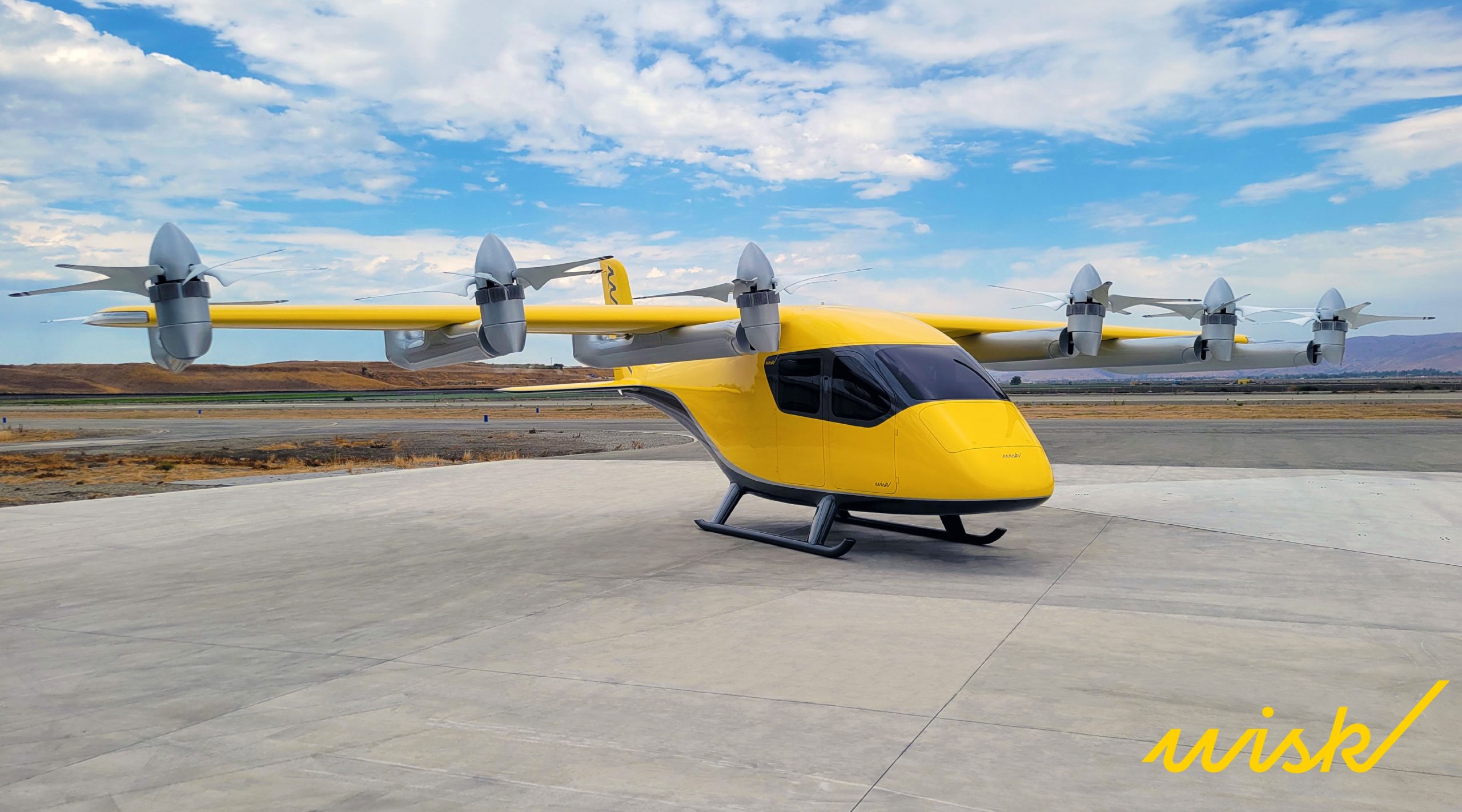
GEN6 eVTOL from Wisk Aero
(Mit freundlicher Genehmigung/Courtesy of Wisk Aero LLC. [Media Kit])

Interieur GEN6 eVTOL from Wisk Aero
(Mit freundlicher Genehmigung/Courtesy of Wisk Aero LLC. [Media Kit])
Wisk Aero emphasizes that autonomous flights should also be possible. It is emphasized that no AI or machine learning approaches will be applied. Instead, the classic technologies already established in commercial aviation, such as autopilots and flight management systems, are to be used.
Wisk Aero’s eVTOL has a safety concept based, among other things, on redundant components (e-motor, e-motor controller, HV battery, etc.). This means that the in-flight failure of a component such as a propeller can be tolerated and can in no way cause the aircraft to crash (no single point of failure).
We did not find any data on the homepage regarding important future milestones such as “certification” as well as “SOP” (Start of Production) of “Generation 6”.
The cell supplier of Wisk Aero is not known to the editors.
Sources
[1] https://wisk.aero/ (Homepage, Access 19.12.2022)
[cs 17.12.2022]
Chinese multicopter start-up founded in 2019. Mr. Xiaopeng, the founder of the EV start-up Xpeng, has held a stake in the company since 2020; the target market is private aviation [1].
The company describes its product – similar to the US start-ups Alef Aeronatics and Aska Fly – as a flying car, although Aerhot’s aircraft can only fly and – unlike the aircraft from Alef and Aska – cannot drive independently.
Instead, a special carrier vehicle was designed for transportation on the road, which can carry the Aerhot multicopter piggybacked on the loading area.

Multicopter and carrier vehicle from Xpeng Aerhot
(Mit freundlicher Genehmigung/Courtesy of XPENG AEROHT [News])
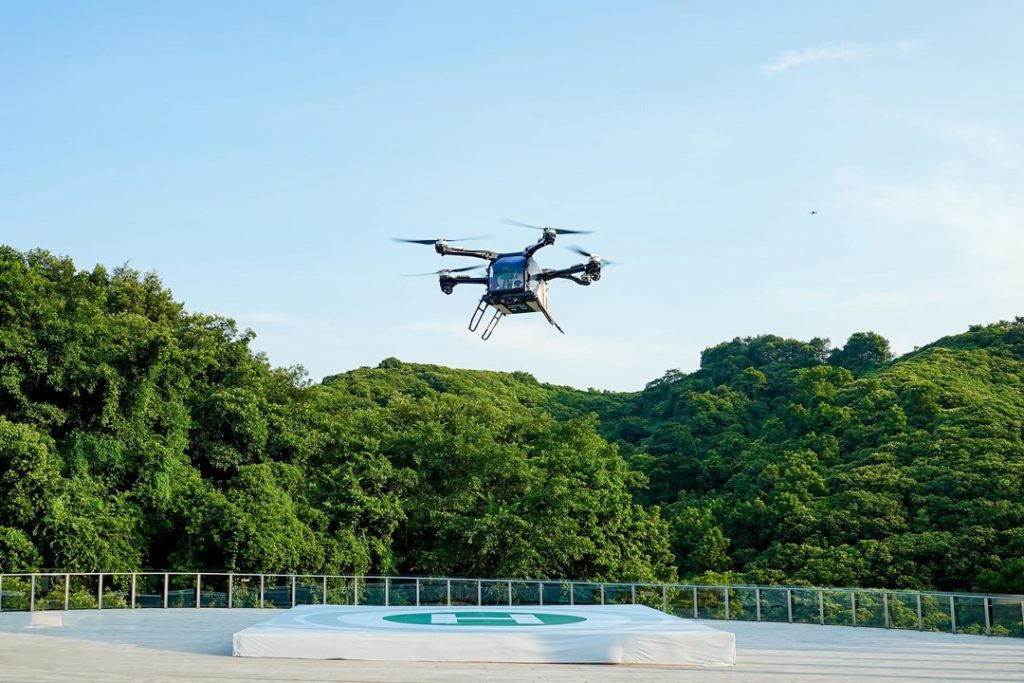
Multicopter from Xpeng Aerhot at a test flight
(Mit freundlicher Genehmigung/Courtesy of XPENG AEROHT [News])
In September 2024, the company demonstrated both products for the first time at a press presentation in the city of Guangzhou (see illustration).
At the presentation, Xpeng Aerhot also presented its product strategy, which is to comprise three phases.
Phase 1 includes the already presented combination product of multicopter and carrier vehicle, which is primarily intended for work in the public sector (public service applications).
In phase 2, a wing-based eVTOL is to be developed for commercial air traffic, while phase 3 will focus on a real flying car.
Concrete milestone plans were not communicated at the meeting.
Sources
[1] https://www.aeroht.com/ (Homepage, Access 13.09.2024)
[2] https://www.aeroht.com/article/article?id=169 (Access 13.09.2024)
[cs 13.09.2024]
US multicopter start-up founded by Stephen Tibbits in 2017, although he began conceptual work on eVTOL aircraft back in 2003.
The company has since been renamed Alpine Vertical and is now working on wing-based eVTOLs.
Below you will find information from 2022 on ZEVA Aero [1].
ZEVA Aero has developed a multicopter prototype called Z2, which looks like a vertical UFO.
On this video you can see the Z2 in flight.

ZEVA Z2 at manned test flight
(Mit freundlicher Genehmigung/Courtesy of ZEVA, Inc. [Homepage])
Technically, Z2 is a single–seat multicopter with a total of 8 vertical propellers, each with 2 counter-rotating propellers mounted in nacelles. Z2’s range is said to be 50 miles (80 km), which Zeva describes as best-in-class. Top speed contributes just under 160 mph (260 km/h).
The Z2 also has a safety concept based, among other things, on redundant components (e-motor, e-motor control, HV battery, etc.), which means that the failure of a component such as a propeller during flight is tolerated and does not cause the aircraft to crash (no single point of failure).

ZEVA SkyDockTM conzept
(Mit freundlicher Genehmigung/Courtesy of ZEVA, Inc. [Homepage])
Zeva’s so-called SkyDockTM concept is particularly futuristic. The idea is that the Zeva multicopter docks at the side of skyscrapers, and the passenger goes directly from the aircraft to the skyscraper. Zeva also refers to this as point–to–point travel, avoiding the time wasted checking in and out of an airport [2].
When and how this SkyDockTM concept will be implemented is not mentioned on the homepage. We also did not find any information about the important future milestones such as “certification” as well as “SOP” (Start of Production) of the Z2.
The cell supplier of Zeva Aero is also not known to the editors, but possibly this has not yet been determined.
Sources
[1] https://www.zevaaero.com/ (Homepage, Access 20.12.2022)
[2] https://www.zevaaero.com/skydock/ (Access 20.12.2022)
[cs 20.12.2022]


